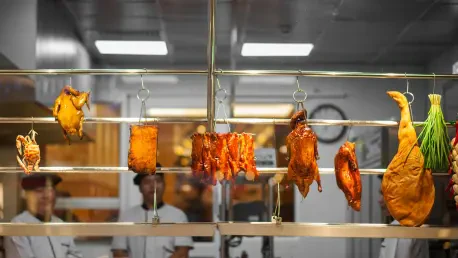In the bustling heart of Bangkok, Thailand, Fi Asia 2025 emerged as a pivotal gathering for the food and beverage industry, drawing innovators, manufacturers, and visionaries from across Asia to showcase groundbreaking developments. This annual event provided a dynamic platform for exploring how companies are adapting to the diverse and ever-evolving demands of Asian consumers, who span a wide range of cultural and economic backgrounds. The challenge lies in creating products that seamlessly blend health benefits, authentic taste, cultural relevance, and affordability—a tall order in a market known for its complexity. Fi Asia 2025 revealed five transformative trends that are redefining the industry, from cutting-edge reformulations to daring flavor profiles. These trends not only reflect current consumer priorities but also signal the direction in which the food landscape is heading, driven by a need to innovate under pressure.
A core theme resonating throughout the event was the intricate balance between tradition and modernity. Asian consumers increasingly seek products that honor their cultural heritage while fitting into fast-paced, contemporary lifestyles. This duality pushes companies to rethink product development, ensuring offerings resonate on both a personal and practical level. The role of technology in bridging this gap was evident, as firms showcased solutions that transform age-old recipes into convenient formats without losing their essence. Sustainability and economic realities further complicate the equation, compelling brands to prioritize affordability alongside innovation. Fi Asia 2025 illustrated how these multifaceted demands are not just challenges but opportunities for creative problem-solving, setting the stage for a deeper dive into the specific trends shaping the industry today.
Emerging Health and Nutrition Trends
Reformulation and Sweeteners
At Fi Asia 2025, a renewed emphasis on reformulation took center stage, particularly in the realm of sweeteners for sugar-sweetened beverages, marking a significant shift after a lull during the COVID-19 period when cost concerns overshadowed health priorities. Dairy Asia’s Sucrost, a Thai-developed hybrid sweetener blending sucrose and sucralose, emerged as a standout innovation. This product leverages proprietary technology to replicate sugar’s taste and functionality across a range of applications, from citrus juices to baked goods, while slashing calorie content. Unlike traditional alternatives that often fall short on sensory appeal, Sucrost minimizes aftertaste and reduces the need for expensive additional blends. This development highlights a broader industry push to align with health regulations and consumer expectations for better-for-you options without sacrificing the indulgence factor that drives purchases in this competitive space.
Beyond the technical advancements, the resurgence of reformulation reflects a strategic response to evolving market dynamics and regulatory landscapes across Asia. Governments have increasingly implemented measures like sugar taxes to curb unhealthy consumption, nudging manufacturers to innovate while maintaining profitability. Sucrost and similar solutions demonstrate how technology can address these pressures by offering versatile, cost-effective alternatives that cater to diverse product categories. The focus isn’t solely on cutting sugar but on enhancing overall product quality, ensuring that health-driven changes don’t alienate consumers accustomed to familiar flavors. This trend underscores the industry’s commitment to balancing public health goals with commercial viability, positioning reformulation as a cornerstone of future growth in the Asian food sector as companies navigate a landscape shaped by both policy and preference.
Functional Foods
The spotlight on functional foods at Fi Asia 2025 revealed a growing consumer appetite for products that deliver tangible health benefits without compromising on taste or visual appeal. Wolffia, a type of duckweed long consumed in Thailand, gained significant attention as a sustainable superfood through efforts by companies like Flo and international players like Ajinomoto. Rich in high-quality protein, antioxidants, vitamins, and minerals, yet low in fat and calories, wolffia offers a nutritional powerhouse that fits into everything from baked goods to beverages. Its eco-friendly profile further enhances its appeal, aligning with rising environmental awareness among Asian consumers. This trend signals a shift where health isn’t just a bonus but a core expectation, pushing brands to integrate nutritional value into everyday food choices seamlessly.
What sets this movement apart is the insistence on sensory satisfaction alongside nutritional gains, as consumers reject functional foods that fail to delight the palate or eye. Innovations like wolffia-based products show how the industry is rising to this challenge by ensuring that health-focused items don’t feel like a compromise. The versatility of such ingredients allows for creative applications that maintain cultural relevance while meeting modern dietary needs. Additionally, the sustainability angle resonates deeply in a region increasingly affected by climate concerns, positioning functional foods as a dual solution for personal wellness and planetary health. At Fi Asia 2025, it became clear that success in this space hinges on a holistic approach, where nutrition, aesthetics, and ethics converge to create offerings that stand out in a crowded market and build lasting consumer trust.
Cultural and Flavor Innovations
Localized Ingredients
A compelling trend at Fi Asia 2025 was the pivot toward localized ingredients, a movement countering the long-standing influence of Western-style diets by adapting global products to regional palates and traditions. Indonesia’s National Research and Innovation Agency presented a striking example with a ready-to-drink beverage derived from sappan wood, a traditional component of the Wedang Uwuh drink known for its antioxidant and antibacterial properties. Historically consumed as a brewed tea, its cumbersome preparation limited widespread adoption. By reimagining it in a convenient canned format, this innovation preserves cultural heritage while catering to the on-the-go lifestyles of younger consumers. This approach not only enhances accessibility but also taps into a growing demand for authentic, health-focused options rooted in local culinary history.
This trend goes beyond mere nostalgia, reflecting a strategic effort to build consumer trust through cultural resonance while addressing practical market needs. Utilizing localized ingredients like sappan wood allows companies to differentiate their products in a saturated market, offering unique selling points that imported concepts often lack. The health benefits validated by scientific research further bolster the appeal, aligning with the region’s increasing focus on wellness. Moreover, innovations in packaging and shelf-life extension open doors to international markets, showcasing Asia’s rich food heritage on a global stage. Fi Asia 2025 highlighted how embracing local flavors and traditions isn’t just a trend but a powerful driver of relevance and loyalty, as brands leverage the region’s diverse culinary tapestry to create products that feel both familiar and forward-thinking to discerning consumers.
Spice and Smoke Flavors
Flavor innovation captured significant attention at Fi Asia 2025, with spicy and smoky profiles emerging as dominant forces in redefining consumer taste experiences. McCormick identified mala—a unique blend of Szechuan peppercorn and chili—as a leading trend, particularly in the snack category. This flavor combines intense heat with a numbing sensation, allowing consumers to savor bold tastes without palate fatigue, thus heightening craveability. Its rise reflects a broader appetite for complex, multisensory profiles that challenge conventional expectations and cater to adventurous eaters across Asia. The ability of mala to transform everyday snacks into memorable experiences underscores the industry’s shift toward creating products that excite and engage on multiple levels.
In parallel, smoky flavors are breaking new ground by venturing into unexpected territories, particularly sweet applications, as showcased by Kerry. Variants like applewood and cherrywood bring a distinctive smoky sweetness to products such as ice creams and honeys, while enhancing roasted notes in coffee and chocolate. This crossover defies traditional flavor boundaries, where smoke is typically tied to savory dishes, and opens up fresh avenues for creative product development. It speaks to a market eager for novelty, where consumers are willing to explore unconventional pairings that elevate their culinary encounters. At Fi Asia 2025, the dual emphasis on spice and smoke illustrated a clear demand for daring, boundary-pushing tastes, signaling that flavor innovation remains a critical battleground for brands aiming to capture attention and loyalty in a highly competitive landscape.
Economic and Market Realities
Affordability Challenges
Economic uncertainty and escalating ingredient costs cast a long shadow over the food industry at Fi Asia 2025, with affordability standing out as a non-negotiable priority for manufacturers navigating volatile markets. Kerry’s insights pointed to ongoing challenges with cocoa prices, projected to remain unstable for the next three to four years due to supply constraints. This situation forces companies to explore alternatives that replicate the beloved chocolate flavor profile while minimizing reliance on costly raw materials. The goal isn’t merely to slash expenses but to maintain the quality and sensory satisfaction that consumers expect, even as economic pressures mount. This trend reflects the real-world constraints shaping purchasing decisions and the industry’s resolve to deliver value without compromise.
Addressing affordability extends beyond ingredient substitution, encompassing broader strategies to ensure accessibility across diverse consumer segments in Asia. Innovations in formulation and processing technologies are enabling brands to reduce production costs while preserving taste and consistency, a critical factor when buyers are unwilling to pay premium prices amid financial strain. The focus on cost-effective solutions also ties into maintaining brand trust, as any perceived drop in quality can erode loyalty swiftly. Fi Asia 2025 demonstrated that affordability is a complex challenge requiring a delicate balance of creativity and pragmatism. Companies must anticipate economic fluctuations and adapt proactively, ensuring that their products remain within reach for a wide audience while upholding the standards that define their market position in these trying times.
Path Forward with Practical Solutions
Reflecting on the insights from Fi Asia 2025, it’s evident that the event painted a vivid picture of an industry in flux, adeptly responding to multifaceted consumer needs through ingenuity and adaptability. The trends—ranging from reformulated sweeteners to localized ingredients, functional foods, bold flavors, and affordability measures—revealed a sector committed to innovation despite economic headwinds. Each development showcased at the event highlighted a unique facet of the Asian food market, where health, culture, and cost considerations intertwined to shape product strategies. The ability to merge tradition with modernity through technology stood out as a recurring strength, ensuring that heritage and convenience could coexist harmoniously.
Looking ahead, the path forward involves actionable steps that build on these observations from Fi Asia 2025. Companies should invest in scalable technologies that support cost-effective reformulation and sustainable sourcing, ensuring health-focused products remain accessible. Collaborations with local research bodies could further unlock the potential of regional ingredients, blending authenticity with market-ready formats. Additionally, exploring unconventional flavor pairings can keep brands at the forefront of consumer curiosity. Tackling affordability will require ongoing vigilance, with a focus on flexible supply chains to mitigate price volatility. These strategies, rooted in the lessons from the event, offer a roadmap for navigating the complex Asian food landscape, fostering resilience and growth in an era of constant change.









